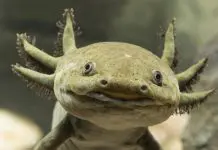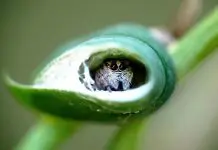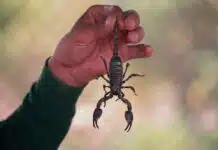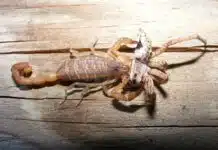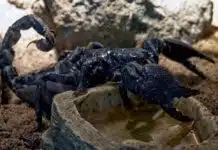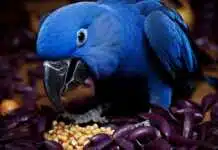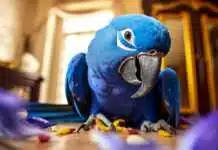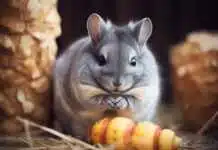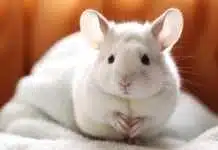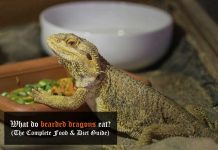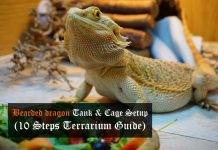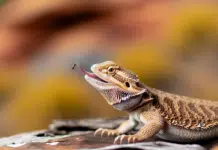Learning how big bearded dragons get is a cool topic with a lot to explore. Your dragon’s species, its age, the environment it lives in, its diet and general health, and even its sex can all affect its length. Understanding the influences on your bearded dragon’s size and length can help you give your beardie a healthy and happy life. So how big can they get?
Bearded dragons in captivity can grow as big as 18 to 24 inches long on average. Females bearded dragon can be as large as 22 inches while males can grow to a size of 24 inches.
Contents
Bearded Dragon Breeds and Sizes
What are bearded dragons?
Bearded dragons are lizards native to Australia. Found mostly in the Northwest Territory, bearded dragons (or “beardies”) are used to harsh environments. In the wild, they prefer to hang around in deserts, woodlands, and savannah areas. They love a hot, dry environment with warm rocks and a sun lamp.
Their spiny outsides suggest that they’re tough, but all types of bearded dragons are typically friendly and responsive to people.
Bearded dragons got their name because underneath their chin is a flap of spiny skin.
When they’re stressed or fearful, the dragons puff out that flap of skin and turn it a threatening black. This makes them look like they’re wearing a full lumberjack beard.
This defensive gesture signals, “Hey, back down!” to other lizards and intimidates would-be predators.
What are the sizes of different bearded dragon breeds?

If you’re wondering, “How big do bearded dragons get?” you may be surprised.
Bearded dragon length differs substantially based on the individual breed.
Measured from end to end (the tip of the nose to the tip of the tail), the longest of the bearded dragon breeds are the Pogona Vitticeps and Pogona Barbata, both coming in at two feet or 24 inches.
The smallest bearded dragons are the teeny Pogona Microlepidota, at a mere 4-6 inches, hardly longer than an average index card.
Many bearded dragons, however, fall somewhere in between those two extremes of length. A number of bearded dragon breeds live happily in the 12-18″ range.
Some of these include the Pogona Minor Mitchelli and the Pogona Minor Minor, which can grow to between 14-18 inches long.
On the slightly smaller end is the Pogona Nullabor at 14 inches.
The Pogona Nullabor has two smaller relatives, the Pogona Henrylawsoni and the Pogona Minor Minima. Both of these varieties average around 12 inches long.
When you’re asking how big do bearded dragons grow, the answer is “It depends.”
This variability is a real asset for pet ownership. Some people would prefer the teeny pocket size of the Pogona Minor Minima or the Microlepidota.
However, you might be more intrigued by the heftier bearded dragon breeds.
If you like the larger species, you’re in good company. The most common breed of bearded dragon is the Pogona Vitticeps, so if you’ve seen a beardie, it’s probably this kind.
Bearded dragons smaller than about 12-14 inches from tip to tip are actually rather rare.
Why are bearded dragon species such different sizes?
Size variation is pretty wide among bearded dragons. It’s possible that because bearded dragons eat a similar diet, being larger or smaller gave an evolutionary advantage.
Larger bearded dragons can hunt larger insects and smaller lizards, and smaller ones can easily hide from predatory birds.
If you’re asking yourself, “How long do bearded dragons get?” look in eastern Australia. The bearded dragon species known as Pogona Barbata can get up to a full 29 inches (75 cm) from head to tail.
Unlike many other lizards, bearded dragons cannot regrow their tails if they fall off, so it’s important to take care of them.
Bearded Dragon Size Based on Age
How do you tell the age of a bearded dragon by its size?
In captivity, breeders can easily tell how old a bearded dragon is. Breeders typically keep careful track of the date on which the bearded dragon female laid her eggs and when they hatched.
In the wild, determining a bearded dragon’s age is not always so easy. Luckily, you can estimate the age of a bearded dragon based on its size (or vice versa).
If you’re looking to buy a young bearded dragon, don’t think it will stay the same size it was when you bought it.
This is a very important consideration when you’re purchasing a tank or other home environment for your bearded dragon.
If your bearded dragon doesn’t have enough space, it won’t necessarily be able to achieve its full mature length.
Knowing that your four-month-old dragon may double in size by the time it’s a year old is crucial. This insight will allow you to plan ahead and get an environment that will allow your beardie to grow and thrive.
A bearded dragon’s size is pretty predictable. By the time they have reached one month old, bearded dragons are approximately 4 inches long.
By six months, your dragons may have quadrupled to as much as 18 inches.
By 12 months, they may be 22 inches or more. How fast do bearded dragons grow?
Here’s a full breakdown:

- 3-4 inches by 0-1 months
- 5-9 inches by 2 months
- 8-11 inches by 3 months
- 9-12 inches by 4 months
- 11-16 inches by 5 months
- 11-18 inches by 6 months
- 13-20 inches by 8 months
- 16-22 inches by 12 months
Bearded dragon age roughly goes along with size, but these are just estimates. Depending on your individual dragon, their length may be longer or shorter.
If you have any concerns about your dragon’s health and growth, it’s a great idea to ask a veterinarian who specializes in reptiles.
How can you estimate a bearded dragon’s age through their sexual maturity?
Bearded dragon gender has a major effect on size. By the time that they reach about 8-12 months old, bearded dragons will become sexually mature and able to reproduce. Anatomy of bearded dragon babies can be difficult to determine. Since all young dragons look female, it’s easier at the 8-12 month period to figure out the difference.
How do you tell the difference between males and females?
Figuring out the sex using bearded dragon anatomy is pretty simple if you know what you’re looking for. The key ideas are vents and dimples.
To take a peek at your dragon’s underside, look near the tail area. Move the tail gently, keeping it below ninety degrees. The bearded dragon’s tail is not designed to lift over its back like a scorpion’s.
On both male and female bearded dragons, you’ll see a horizontal slit near the tail. However, male bearded lizards will have a distinctive difference.
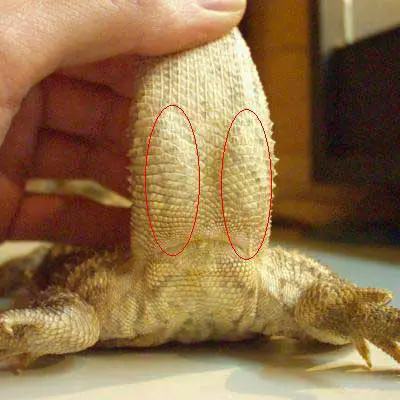
Just above the vent on either side will be two raised dimples that look like two fingers making a peace sign under the lizard’s belly skin.
On the other hand, the female won’t have raised dimples. Instead, she’ll have a small bump right above the vent.
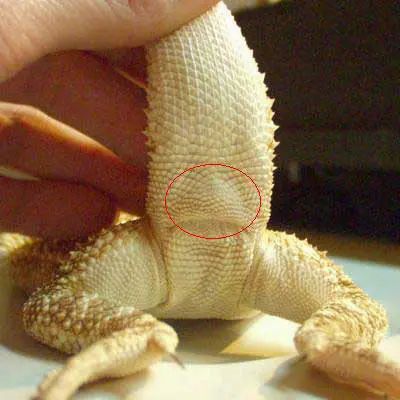
If you’re still not sure, the tails of male beardies are usually thicker at the base than those of females. However, the “look for the dimples” method is more accurate.
Environment and Size
How does a bearded dragon’s environment affect its size?
Your bearded dragon’s environment will have a tremendous impact on its size and overall health. Lots of people know that fish will expand or limit their size to fit the tank they’re in.
The same is true for bearded dragons. Knowing the average length of your adult beardies will help you find the right sized environment for them to live and grow.
How large do bearded dragons get? Well, if you’re not sure what size tank to get in general, it’s better to go a little bigger.
An environment that’s too small will ultimately restrict your beardie’s growth and make it difficult for it to move around.
Your bearded dragon likes to climb branches and sun itself on warm rocks beneath a lamp. If possible, some beardies like to interact with other dragons and forage for food.
A healthy range of activities for your bearded dragon requires some space.
Here are some rough guidelines to help you choose the right tank for your bearded dragon:
Baby Dragons: Baby dragons need a smaller 20-gallon tank to allow them space to move around and interact with their environment.
This is the stage where they learn the fundamental skills of running and climbing. At least for the time being, it’s fine if they’re in a 20-gallon tank. They may be housed in a larger tank.
However, if they’re having a hard time running around to catch live food such as crickets, they may need to be fed by hand.
There are a few 20-gallon tank options to choose from:
- Exo Terra 20 Gallon Outback Terrarium – 24″ x 18″ x 12″
- Tetra Deluxe Aquatic 20 Gallon Tank – 30″ x 12″ x 12″
- Aquarium Masters 20 Gallon Aquarium – 30″ x 12″ x 12″
Juvenile Dragons: These more energetic dragons of 10-16 inches need the space to play and have fun, particularly if you have more than one bearded dragon.
At this stage, a 40-gallon tank is a bare minimum for one bearded dragon, but it’s still best to go larger rather than smaller.
16-20″ Dragons: Dragons of 16″ or more need tanks at least 50 to 75 gallons or so for optimal health and growth. Remember that a too-small tank will restrict their full adult growth.
Even more importantly, they won’t be as happy or fulfilled as they would be in a larger tank that allowed them to move.
Some suitable options for juvenile dragons:
- REPTI ZOO Reptile Glass Terrarium (50 gallons) – 36″ x 18″ x 18″ or 36″ x 18″ x 24″
- Carolina Custom Cages Terrarium (90 gallons) – 48″ x 24″ x 18″
Larger Dragons: A dragon 20 inches or more will need a significantly larger tank. At the minimum, a 75-gallon tank would be adequate, but 120 gallons or more would be ideal.
Suitable aquariums for giant bearded dragons:
- Carolina Custom Cages 120 gallon Terrarium – 48″ x 24″ x24″
- Carolina Custom Cages 150 gallon Terrarium – 72″ x 24″ x 18″
How do I set up a tank for my bearded dragon?
Once you’ve determined a good size for your beardie, you’re going to need to figure out what kind of environmental setup they’ll need.
Your bearded dragon needs a warm place to sun himself, a suitable substrate to keep his environment clean, and a supply of food and water.
Keeping your bearded dragon at an ideal temperature and humidity are also important considerations.
Check out some helpful information here to read more about an ideal tank/vivarium arrangement to give your bearded dragon the best environment possible.
Size and Diet
Does diet have an effect on bearded dragon size?
Diet plays a major role in the health and growth of your bearded dragon. Although bearded dragons are omnivorous, there are ideal balances of protein and greens to optimize their health.
A proper diet can promote healthy bearded dragon growth, but an improper one can restrict it.
Adult bearded dragons will need a diet split between insects and plants. About 25-30% of their adult diet should come from insects and about 70-75% from leafy greens like kale and vegetables and roots such as sweet potato.
Crickets, roaches, and phoenix worms should typically make up the biggest part of your beardie’s protein supply.
Bearded dragons do enjoy treats such as rich, fatty butter worms, but those should be food for special occasions only. (Think of them as the chocolate chip cookie of the bearded dragon diet.)
Here are some popular live insects providers for bearded dragons:
- Banded crickets from Josh Frogs
- Dubia Roaches
- Premium Black Soldier Fly Larvae (Phoenix worms) from DBDPet
- Butter Worms from Elliot’s
For veggies, your beardie will like collards, kale, broccoli, sweet potato, and other healthy greens and roots.
These greens should be chopped and generally made easy to eat, but to prevent overfeeding, you can try methods to encourage foraging.
Making mealtime into foraging time is not just better for your dragon to prevent obesity, but it’s more fun for them as well.
To make sure your dragon stays healthy and achieves its optimal growth, one of the most important ingredients in their diet should be a vitamin and mineral supplement.
In the wild, bearded dragons usually get a balanced diet. In captivity, a dragon may lack certain nutrients even with a varied diet. Calcium and vitamin D3 are two of the most important nutrients for your dragon’s growth.
Calcium strengthens healthy bone tissue and vitamin D3 helps this process. Without enough calcium in their diet, bearded dragons can suffer from metabolic bone disease. Metabolic bone disease can cause bones to become weak and brittle.
Your lizard may experience bone breaks, disfigurement, or death. Along with a calcium and vitamin D3 supplement, it’s important to give your bearded dragon good light.
Exposure to UVB rays helps animals metabolize calcium, which is vital for good bone health.
Vitamin and mineral supplements should be added to food on a regular basis. Most supplements are available in a powdered form that you can shake over vegetables or over crickets and other insects before feeding.
You may want to read more about the bearded dragon diet here or find additional information about the best type of supplements to look for.
Important supplements to mix with bearded dragon food:
- Zoo Med Reptile Calcium Without Vitamin D3
- Fluker’s Repta Calcium With Vitamin D
- Zoo Med Reptile Calcium With Vitamin D3
- Rep-Cal Multivitamin
It’s vital to research the appropriate foods to give your bearded dragon and find out which ones to avoid.
Spinach, for example, should not be given to bearded dragons very often. Spinach can be a calcium-binding agent that makes it harder for the bearded dragon to absorb calcium and may lead to metabolic bone disease.
Some dragon owners may not know that avocados are toxic to beardies.
In order to get good in-depth information about your bearded dragon’s diet, check out this helpful nutrient guide on bearded dragon diet. Your dragon’s diet can help him grow to his best size and stay healthy for a long time.
Gender and Size
How big do male and female bearded dragons get?
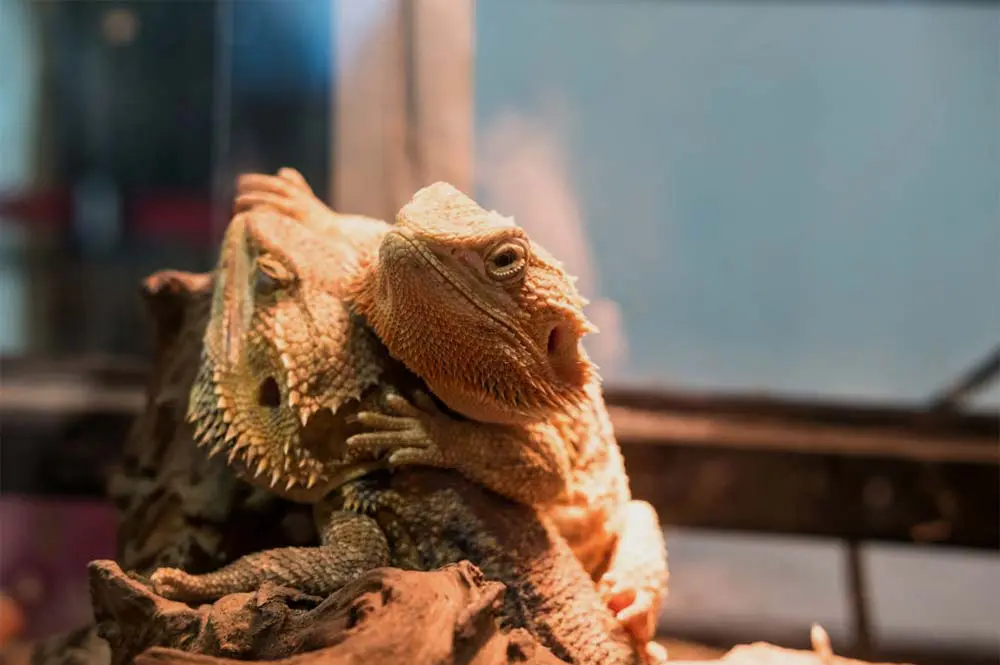
Gender has a major effect on the length of your bearded dragon. Before they are about six to eight months old, it’s hard to tell the sex of a bearded dragon.
All of the young dragons appear to be female and they tend to be of comparable length. By the time that they are between 12-18 months old, bearded dragons should reach their full adult size.
After your beardie reaches sexual maturity, you will probably see a more visible difference in size between male and female lizards from the same clutch.
How big do male bearded dragons get?
Bearded dragons will generally grow to between 18-22 inches at their full length from the tip of their noses to the tip of their tails.
In the wild, they may be longer, possibly up to 24 inches. Like many species of animals, male bearded dragons are somewhat larger than females, although the distance is not dramatic.
Male bearded dragons will be closer to the 22-inch range if they have been properly fed and housed during their developmental periods.
How big do female bearded dragons get?
Female bearded dragons tend to the smaller end of the range. If a fully adult dragon averages from 18-22 inches, your female bearded dragon is probably closer to 18 inches in captivity.
However, factors such as environment, diet, breed, and even UVB exposure can affect your dragon’s length. In other words, it may not always be able to tell which of two dragons is female based on length alone.
If you want to find out more information about determining the sex of your bearded dragon, check out this helpful blog for tips and tricks.
Conclusion
With their mellow, friendly nature, bearded dragons make great pets for brand-new lizard fans and experienced pros alike.
Watching them grow from tiny hatchlings to full adults is a fascinating experience. Providing bearded dragons with an open, warm, stimulating environment allows them to enjoy life.
They have plenty of room to explore their favorite activities and grow to an optimal length.
Different species, environments, sex, and overall health and diet are all crucial factors influencing your bearded dragon’s health.
With a healthy lifestyle including calcium and vitamins, a spacious enclosure, and lots of activities, your bearded dragon should be able to grow to its fullest healthy length.
Know someone who’s thinking of getting a bearded dragon? Share this information with them and leave your insights and comments below for other fans of bearded dragons everywhere.

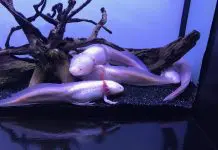

![Sick Axolotl, Fungus, Stress Symptoms [Axolotl Illness Guide 2025] Axolotl fungus](https://exopetguides.com/wp-content/uploads/2018/06/axolotl-218x150.jpg.webp)
